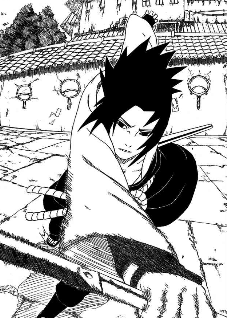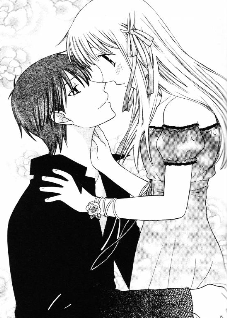

This is a topic I have never given much thought to, but it recently came up during a conversation I had with a friend. I always assumed that a more-or-less singular definition of shojo and shonen anime/manga was agreed upon by everyone involved in anime. But I can see now that that’s not entirely so…
For many years now, when I think of shojo anime, I always thought it was defined by themes of romance and interpersonal conflicts, and featured at least one female protagonist and a few or more bishounen with whom her emotional relationships revolve around. Series like Fushigi Yuugi, Fruits Basket, and a number of CLAMP and mahou shojo series fell into the category. But because I always assumed any series focusing on romance between attractive characters was shojo, I also mistakenly assumed that series like Love Hina, Chobits, and Oh My Goddess! were of that genre as well. But now I realize that the main defining point of shojo is not the romance, but simply the target audience – young girls. I believe Love Hina, Chobits, and Oh My Goddess! were marketed as shojo anime/manga in the U.S., but in Japan they are considered shonen. Although they’re focused on romance and character relationships, the protagonists of these three series are males surrounded by pretty females, while most shojo series feature female protagonists surrounded by pretty males.
However, the target audience of series defined as shojo remains the same in both Japan and the U.S. – it’s just that U.S. companies felt that series like Love Hina, Chobits, and Oh My Goddess! would have a larger female following and thus they were marketed as shojo, even though in Japan they have a larger male following and are marketed as shonen. This seems to be a basic cultural difference – in the U.S., it’s assumed that boys are not interested in stories involving romance, character relationships, or too many female characters; they would rather watch/read action or adventure series involving males with super powers, such as those in obviously shonen series like Naruto and One Piece. Although this is true for boys in Japan as well, some boys would rather fantasize about being that male protagonist among the females in series like Love Hina, Chobits, and any number of the harem anime/manga out there. This kind of fantasizing within animation is definitely not as integrated in the U.S. as it is in Japan, which is probably another reason why these kinds of series are not marketed towards boys in the West.
The Western definition of shojo is sometimes blurred even more when people define any series with female protagonists as shojo, even general slice-of-life/comedy series like Azumanga Daioh, Lucky Star, and K-ON!. Like the aforementioned shonen series involving romance and character relationships, it’s assumed in the U.S. that boys would not want to watch/read a “cutesy” series about the daily lives of girls and are only interested in “masculine” action, adventure, fantasy, or sci-fi series. But of course, anyone familiar with the fan following of these shows knows that the majority of fans are males, and the target audience is primarily male otaku. The male otaku who obsesses over female anime/manga characters and will watch/read a series simply for the cute girls, is a phenomena that is still unknown among average Westerners.
When it comes to shonen series, I always assumed the definition stemmed from the themes rather than the target audience. A shonen series is usually an action/adventure epic that has a lot of male characters who have super powers and are constantly engaged in suspenseful battles with wicked villains. This is probably the most widely accepted definition of shonen, especially in the U.S., and is again why the “other” shonen series like Love Hina and Azumanga Daioh are not not looked upon as boys’ series in the West.
A recent panel by Daryl Surat at this past Otakon discussed how shonen anime/manga has changed over the years; it used to be targeted strictly for males and featured only very masculine, muscle-bound male characters. However, creators realized that they should consider the female audience too, and shonen series thus started to feature more attractive and less masculine-ish male protagonists whom girls would like. As a result, shonen series produced in the past 20 years or so have a much larger female following. Boys are still the primary target audience and are still what makes a series shonen, but female fans are definitely considered as well.
In conclusion, it seems that there isn’t one particular theme or genre that defines a series as shonen or shojo – it comes down to the target audience. Shojo series seem to always have romance and pretty boys because that’s what girls want to read about, just as boys want to read about the action and adventure in shonen series. And for the boys who would rather watch/read stories about cute girls, series like Love Hina, Kannagi, and Lucky Star exist. Some shojo and shonen series are categorized differently in the U.S. because of differing assumptions about what boys and girls want to indulge in. But although we have these categories, there are always exceptions; there are plenty of girls who love shonen and boys who enjoy shojo. In the end, I guess it comes down to personal taste =)
Yeah, I always considered Lucky Star, Haruhi Suzumiya, Azumanga Daioh, Chobits, etc. to be shoujo animes/mangas. They’re all about mainly girls who talk about GIRL stuff, y’know? I also think of Air, Kanon, and Clannad to be shoujo because of it’s touching, make you wanna cry stories and characters. When I found out that they were shounen, I was just like “OMG!!!!! What boy wants to read cutesy stories!?” Like you said. So basically, the whole “Moe otaku” portion of Japanese boys and men that go for that stuff still remain an enigma to me. However, the fact that you point out that a lot of girls like to read/watch the whole “bishounen, female protagonist, romance” stuff is pretty interesting. I like some shounen animes like Pokemon (even though a lot of girls like that too), Code Geass, Death Note, etc., but I do go for some shoujo stories too like Fruits Basket, Vampire Knight, Ouran Host Club, etc., etc. I guess I just like to fantasize about the attractive male characters and wishing I was the female protag. But once again, you make a very good point.
On a related note, have you ever seen the websites for galgames? It’s amazing how flowery and pink and astonishingly feminine they are.
Lulz, I thought that the target audience AND the art style counted, cos generally Shounen would have more fierce characters and Shoujo would have the big eyes. But you just pointed out a HUGE importance to the target audience side, so I guess they both count a lot.
What about Aishiteruze Baby? ^.^
Ahh, the classic confusion. It’s like people who talk about Yotsuba&! as a kids manga, until I tell them that it was published in a magazine for adult men. It’s ALL about target audience. And as Daryl pointed out in the panel that you mentioned, the target audience for shonen has become increasingly female, leaving fans of exclusively masculine anime and manga with nothing but the darkest depths of seinen.
There is one other factor besides target audience, however, that can very easily tell you whether an anime or manga is shonen or shojo – something called the “object of desire.” Which characters are displayed in a way that makes them most attractive to the opposite sex?
In shonen like Haruhi, the girls are given widely varying color schemes, personalities, and interesting costumes, so that male viewers can easily pick out their favorites based on their moé fetishes. On the other hand, the guys wear boring suits and both have short-ish brown hair. In Fushigi Yugi, it is the boys who are the objects of desire. They all have vastly different personalities, hair colors/lengths, costumes, and skills, so that girls can pick out their favorites based on their bishonen fetishes. The main character Miaka is nothing but a klutzy, forgettable “average girl.”
@ Vampt Vo
What you said about giving either male or female characters, depending on the target audience of the series, various color schemes, designs, and personalities, is very interesting. In most of the harem anime I’ve seen, the one main male character is fairly cliche and uninteresting, while the females have distinct looks and attributes. And in most male harem series, the male characters are diverse and attractive, while the female protagonist is an unforgettable “Mary Sue.” There are plenty of exceptions of course, but that’s a good point.
I never thought of it that way. All this time I’ve been thinking the exact same thing as Yukina. But thanks to you, I have a better understanding of shonen and shojo anime now.
Um… Ah! My Goddess and Chobits are Seinen…not Shōnen. Also..guys won’t always like manga like Suzumiya Haruhi no Yuutsu or Love Hina because of just the cute girls…there are guys that like romance or just the storylines found within those kind of stories.. Or there’s guys like me that just prefer a good mix of romance and action/adventure like Elfen Lied, 3×3 Eyes, Xblade, etc.
WHY LUCKY STAR IS ASSIGNED WITH SHONEN?
im confused now this anime has only girl stuff and its cute why its shonen?
The reason why Lucky Star is shounen is its because of the target audience. In Japan, shounen also contain fanservice elements.
Love Hina is a shonen, however Chobits and Oh My Goddess! are actually classified in the Seinen demograpic
Most of those shows like Ah! My Goddess! and Love Hina are technically labeled “Shounen-ai” but I think they should more shows like “Birdy the Mighty” and “Blood+” that don’t really fit the shoujo thing but are more kind of shounen, right?
Check out The Otaku Reviewers blog here:
http://www.otakureviewers.com